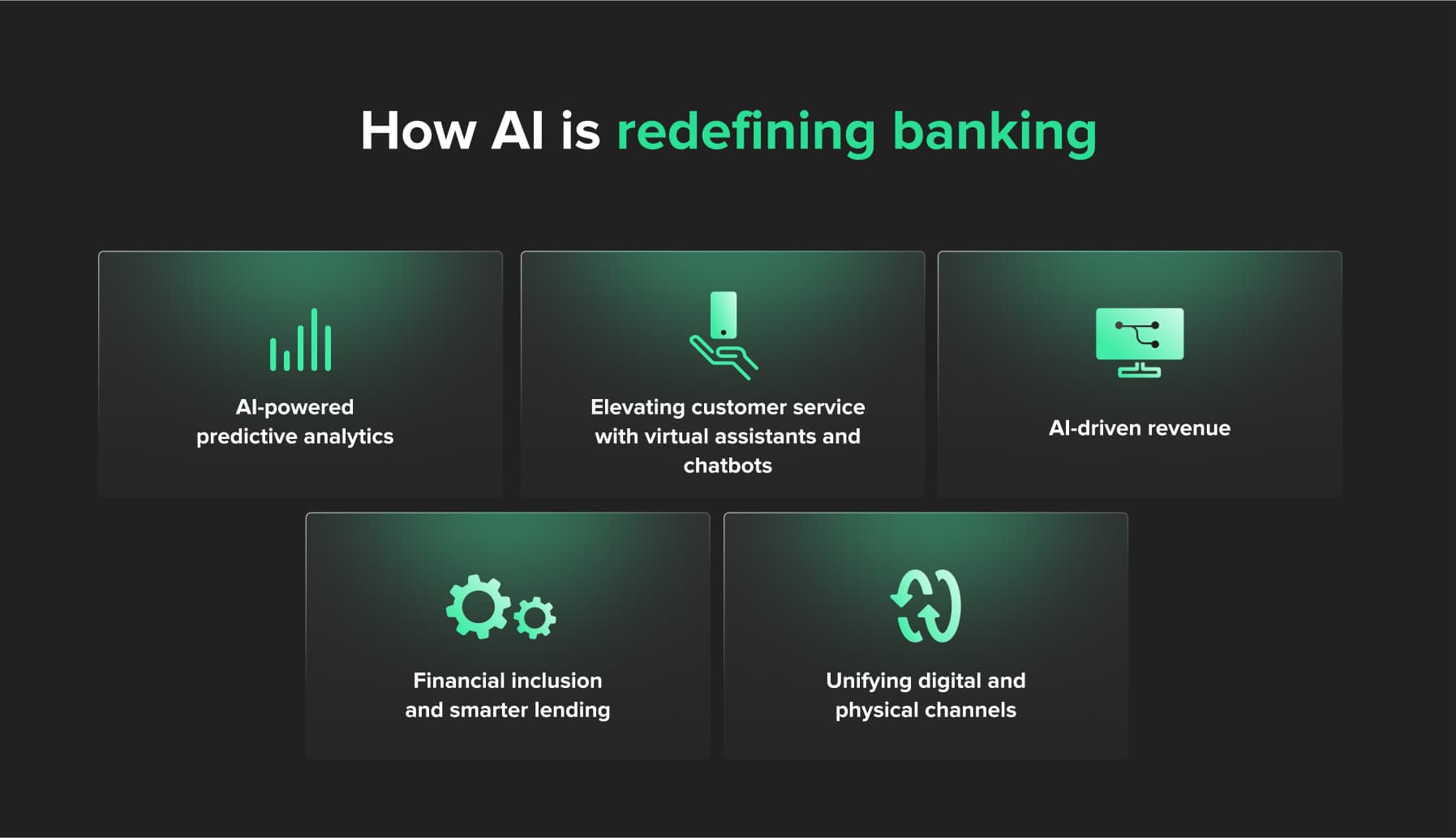In the world of banking, digital transformation has been more of a slow march than a sprint. Hindered by legacy systems, regulatory hurdles and a cautious approach to innovation, banks have struggled to keep pace with the digital era. And just as they begin to find their footing, a new challenger emerges: AI.
With its potential to revolutionize everything from customer service to risk management, AI poses a critical question to already overwhelmed institutions. Is it time to jump on the AI bandwagon or risk falling further behind? As we navigate this uncertainty, one thing is clear: the decisions made now will shape the future of banking.
How to use AI in banking
In this article, we'll delve into the ways AI can be used in banking and explore its applications, benefits and the unparalleled advantages it brings to the banking industry.
AI-powered predictive analytics
The rise of AI-powered predictive analytics stands out as one of the most significant advancements in recent times, offering millions of customers access to affordable finance and improved money management. The ability to analyze vast amounts of transaction data in real-time has equipped banks with the tools to better understand their customer’s needs and provide tailored services.
Banks worldwide are gearing up to invest an additional $31 billion in AI, embedding it into existing systems by 2025, as highlighted in the Jones Lang LaSalle’s 2023 Banking and Finance Outlook report.
By using real-time analysis and insights from transaction AI across their entire portfolio, banks can better understand their customers and serve them accurately and immediately.

George Dunning
COO at Bud Financial
Virtual assistants and chatbots
Virtual assistants and chatbots are taking customer service to new heights, offering round-the-clock support and proactively addressing the impacts of economic changes, such as inflation, on a customers' budgets. These AI-driven tools are not just benefiting customers; they are also streamlining processes for lenders, from income verification to supporting borrowers in financial distress.
However, it's crucial to approach AI in banking and automation with a discerning eye. Over-reliance on automated systems can lead to potential pitfalls, jeopardizing the trust and loyalty banks have worked hard to build with their customers. In instances where technology falters or bias is present in automated decision-making, the consequences can be severe, eroding customer trust and potentially leading to long-lasting damage to a bank's reputation.
In order to mitigate these risks, banks must strive to maintain a delicate balance. While you leverage the efficiency and accuracy of AI in finance, you also need to preserve the human touch in customer interactions. This balance is key to fostering an environment where technology enhances rather than replaces the human element, ensuring that customer trust is maintained even as services are optimized.
AI-driven revenue
The integration of AI in banking is transforming the landscape of embedded finance and open APIs, turning banks into pivotal players within an evolved financial ecosystem. By effectively utilizing AI to process and analyze vast streams of customer data, banks are uniquely positioned to empower fintechs, facilitating a range of financial services directly through smartphone applications.
This not only enhances the consumer experience but also opens up diverse revenue channels for the banks themselves.
"Banks are sitting on a goldmine of customer data, and with AI, they have the unprecedented opportunity to leverage this data, supporting fintechs on the backend while ensuring compliance and trust," highlights Olivier, Head of FinTech at Star. "This doesn’t just put banks in the driver’s seat; it creates a sustainable business model, ensuring their relevance and resilience in the digital age."
This symbiotic relationship not only opens up new revenue streams for banks but also fosters a sustainable business model that propels the entire financial ecosystem forward.
By striking the right balance, banks can harness the full potential of AI and turn data into opportunities, and position themselves as indispensable facilitators in the fintech revolution.
Financial inclusion and smarter lending
In the past, banks have relied on historical data to determine creditworthiness. However, AI models can analyze a broader set of data, including social media activity and other non-financial information. This enables banks to make more informed lending decisions and extend credit to those who would have been deemed too risky in the past.
One area where AI has improved financial inclusion is by facilitating access to credit. Traditional credit-scoring algorithms often excluded individuals such as part-time workers in the gig economy because they lacked a sufficient history of full-time employment with a single company.
By analyzing a broader set of data, banks can better evaluate the risk posed by these individuals and offer them access to loans or other forms of credit.

Unify digital and physical channels
Despite the advancements, the challenge remains to unify the customer journey across digital and physical channels.
Amit Dua of SunTec Business Solutions highlights the necessity of this integration, stating: “Using technology to address consumers’ needs and preferences will be crucial to ensuring their continued loyalty. For banks to remain relevant in the long run, they must also start thinking about unifying the customer journey across the physical and digital channels.”
Through predictive analytics, personalized recommendations and intelligent automation, AI facilitates a deeper understanding of customer behaviors and preferences, meaning that every interaction, be it in a branch or through a mobile app, is tailored to their needs.
By leveraging AI to analyze customer data from both digital and physical interactions banks are able to gain a holistic view of their customer journey. Simultaneously, this enables them to optimize each touchpoint, creating a fluid, coherent experience that reflects the convenience of online banking while retaining the personal touch of in-branch service.
Aligning AI with your banking transformation
The banking sector is at a pivotal point. The strategic application of AI in banking isn't just enhancing existing processes and services, it's opening doors to new possibilities and opportunities. As banks continue to navigate through this digital transformation, the focus must remain on aligning technology with customer needs, ensuring a seamless experience across all channels, and fostering long-term relationships built on trust and efficiency.
For a deeper dive into the transformative forces in banking, including AI, ESG, and fintech partnerships and to understand how your bank can leverage disruptive technologies for strategic advantage, download our comprehensive report on "Innovation and transformation in banking."





